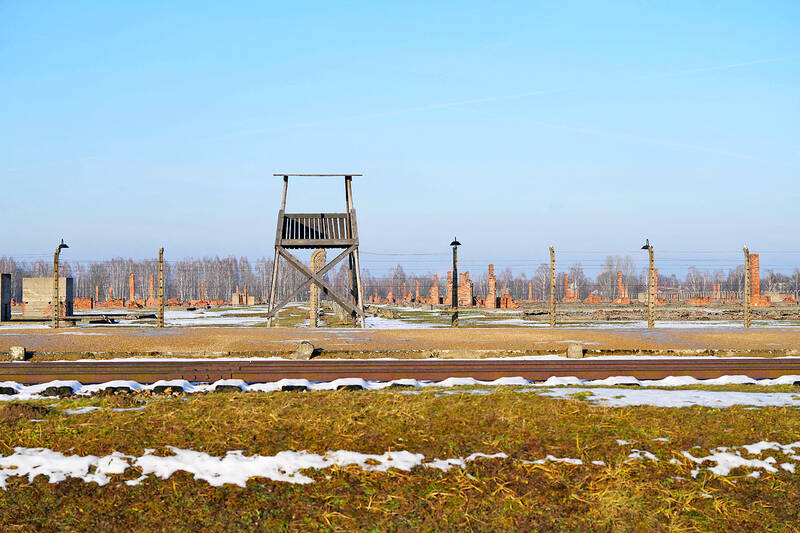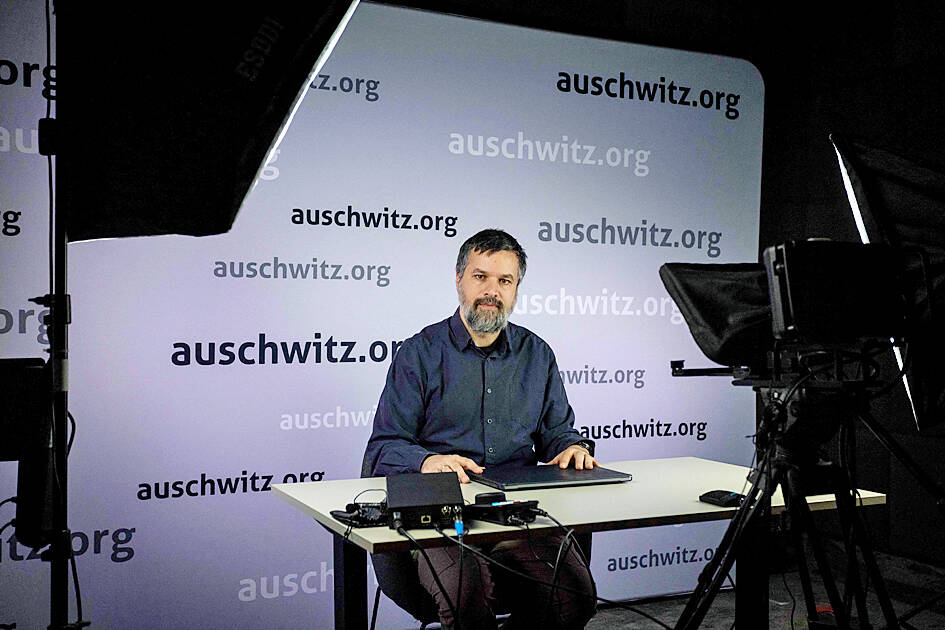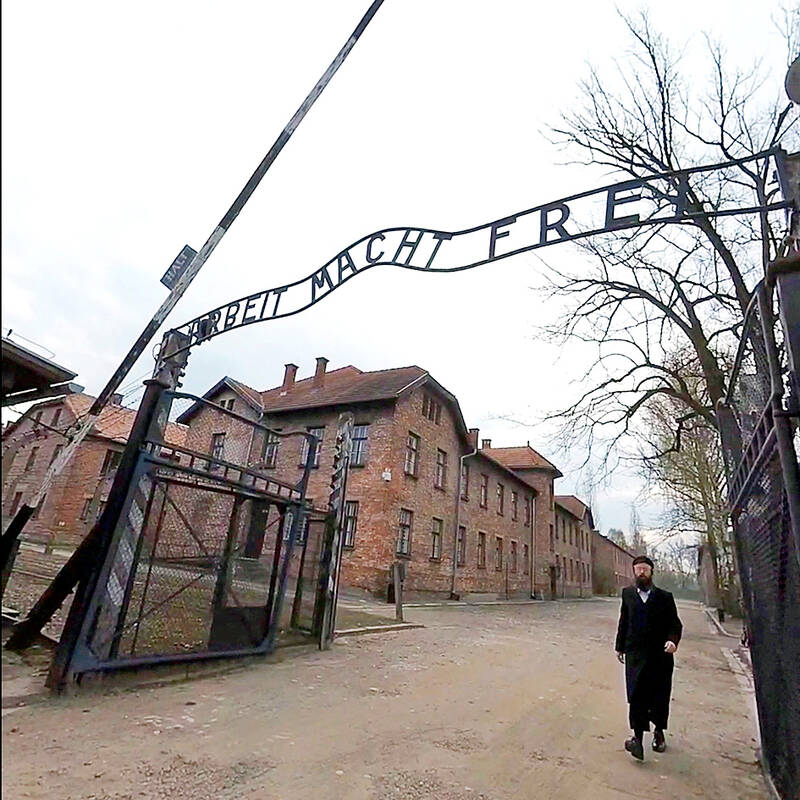Barbed wire lines the road to work for Pawel Sawicki, deputy spokesman of the Auschwitz museum at the site of the former Nazi death camp that was liberated 80 years ago. More than 1 million people died at the Auschwitz-Birkenau camp built by Nazi Germany when it occupied Poland in World War II — most of them Jews, but also non-Jewish Poles, Roma and Soviet soldiers.
About 850 people work at the museum to preserve their memory, a job with more emotional baggage than a usual nine-to-five.
“They say that when you start working here, either you leave very quickly because the history is too much or you stay for a long time,” said Sawicki, who is in charge of social media at the museum and has worked there for 17 years. “It helps if you find some meaning to the mission,” the 44-year-old said. Sawicki’s office is inside a former hospital for the Nazis’ notorious SS.

Photo: AFP
Behind the building, there is an old gas chamber and farther on stands the camp’s “Arbeit Macht Frei,” meaning “Work will set you free,” gate.
To cope with the heavy emotional toll of working at Auschwitz, Sawicki said he has put up “a sort of professional barrier” that keeps him sane, even if it cracks from time to time.
Jacek Paluch, a longtime Auschwitz tour guide, said he makes sure to leave his “work at work” to avoid going crazy, “but it’s a special job and a special place. It’s impossible to leave all the history behind and not take it home with you,” he said.

Photo: AFP
The 60-year-old said he leads up to 400 groups of visitors each year around the former death factory.
More than 1.8 million people visited Auschwitz last year. The museum offers tours of the site in more than 20 languages, led by around 350 guides. The hardest, most emotional moments for Paluch are his encounters with former prisoners.
Once, Paluch came across a man sitting silently — and unresponsive to questions — on a bench, his arm tattooed with his former inmate number. “His whole life, he never spoke a word to his family about what had happened here. Then, suddenly, at one Sunday breakfast, he began to talk,” Paluch said.

Photo: Reuters
“They stopped him and took him here so that he could tell his story where it happened... but when he walked through the ‘Arbeit Macht Frei’ gate, the memories came back. He went quiet again and no longer wanted to talk about any of it,” he said.
Paluch said he knows when the job has taken its toll.
“A sign of fatigue, not necessarily physical but more mental, is when I have dreams at night that I’m leading groups,” he said. “That’s when I realize I need to take some time off.”
Wanda Witek-Malicka, a historian at the museum’s research center, had for years focused on children inmates of Auschwitz, but she had to abandon the difficult subject when she became a mother.
“At that moment, this particular aspect of Auschwitz history — children, pregnant women and newborns — I was in no state to handle it,” she said.
Elsewhere at the site, conservator Andrzej Jastrzebiowski examined some metal containers once filled with Zyklon B, the poison gas used to kill inmates at Auschwitz.
He recalled his anger early on — he has worked at the museum for 17 years — when he had to conserve objects that had belonged to the Nazis. “Later, I realized these objects had importance as evidence of the crimes committed here, and maintaining them is also part of our mission here,” the 47-year-old said.
Jastrzebiowski and his colleagues at the high-tech conservation department are responsible for preserving hundreds of thousands of items, including shoes, suitcases, metal pots, toothbrushes, letters and documents.
Most of the items had belonged to inmates before being confiscated upon arrival. The conservators are also responsible for preserving the camp barracks, the barbed wire, the remnants of the blown-up crematoriums and gas chambers, and other ruins at the site.
It is work of utmost importance, especially at a time when the number of living former inmates is dwindling fast.
“Soon there will be no more direct witnesses to testify and all that will remain are these items, and they will have to tell the history,” Jastrzebiowski said. “Our job is to give them a voice.”
When he works on an item, he tries to discover the object’s peculiarities to keep the job from becoming a mindless routine.
“It helps me to think of the items’ owners, their stories,” he said.
“Most of all, it’s the opposite of what the Nazis had wanted — that their memory vanish, that they disappear forever,” he added.
International Holocaust Remembrance Day is on Monday next week.

Kehinde Sanni spends his days smoothing out dents and repainting scratched bumpers in a modest autobody shop in Lagos. He has never left Nigeria, yet he speaks glowingly of Burkina Faso military leader Ibrahim Traore. “Nigeria needs someone like Ibrahim Traore of Burkina Faso. He is doing well for his country,” Sanni said. His admiration is shaped by a steady stream of viral videos, memes and social media posts — many misleading or outright false — portraying Traore as a fearless reformer who defied Western powers and reclaimed his country’s dignity. The Burkinabe strongman swept into power following a coup in September 2022

‘FRAGMENTING’: British politics have for a long time been dominated by the Labor Party and the Tories, but polls suggest that Reform now poses a significant challenge Hard-right upstarts Reform UK snatched a parliamentary seat from British Prime Minister Keir Starmer’s Labor Party yesterday in local elections that dealt a blow to the UK’s two establishment parties. Reform, led by anti-immigrant firebrand Nigel Farage, won the by-election in Runcorn and Helsby in northwest England by just six votes, as it picked up gains in other localities, including one mayoralty. The group’s strong showing continues momentum it built up at last year’s general election and appears to confirm a trend that the UK is entering an era of multi-party politics. “For the movement, for the party it’s a very, very big

ENTERTAINMENT: Rio officials have a history of organizing massive concerts on Copacabana Beach, with Madonna’s show drawing about 1.6 million fans last year Lady Gaga on Saturday night gave a free concert in front of 2 million fans who poured onto Copacabana Beach in Rio de Janeiro for the biggest show of her career. “Tonight, we’re making history... Thank you for making history with me,” Lady Gaga told a screaming crowd. The Mother Monster, as she is known, started the show at about 10:10pm local time with her 2011 song Bloody Mary. Cries of joy rose from the tightly packed fans who sang and danced shoulder-to-shoulder on the vast stretch of sand. Concert organizers said 2.1 million people attended the show. Lady Gaga

SUPPORT: The Australian prime minister promised to back Kyiv against Russia’s invasion, saying: ‘That’s my government’s position. It was yesterday. It still is’ Left-leaning Australian Prime Minister Anthony Albanese yesterday basked in his landslide election win, promising a “disciplined, orderly” government to confront cost-of-living pain and tariff turmoil. People clapped as the 62-year-old and his fiancee, Jodie Haydon, who visited his old inner Sydney haunt, Cafe Italia, surrounded by a crowd of jostling photographers and journalists. Albanese’s Labor Party is on course to win at least 83 seats in the 150-member parliament, partial results showed. Opposition leader Peter Dutton’s conservative Liberal-National coalition had just 38 seats, and other parties 12. Another 17 seats were still in doubt. “We will be a disciplined, orderly